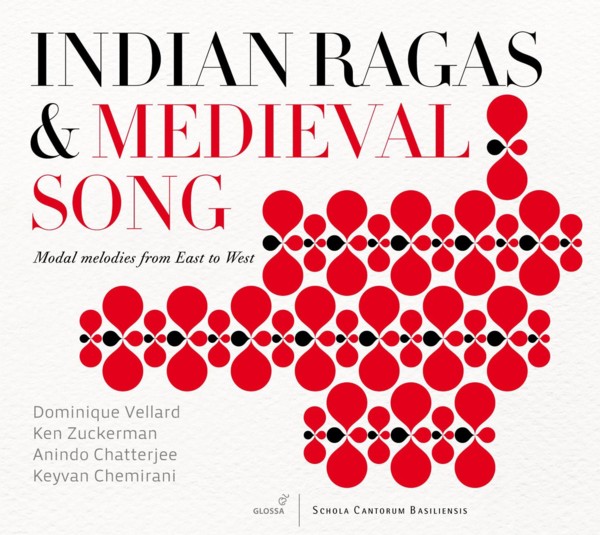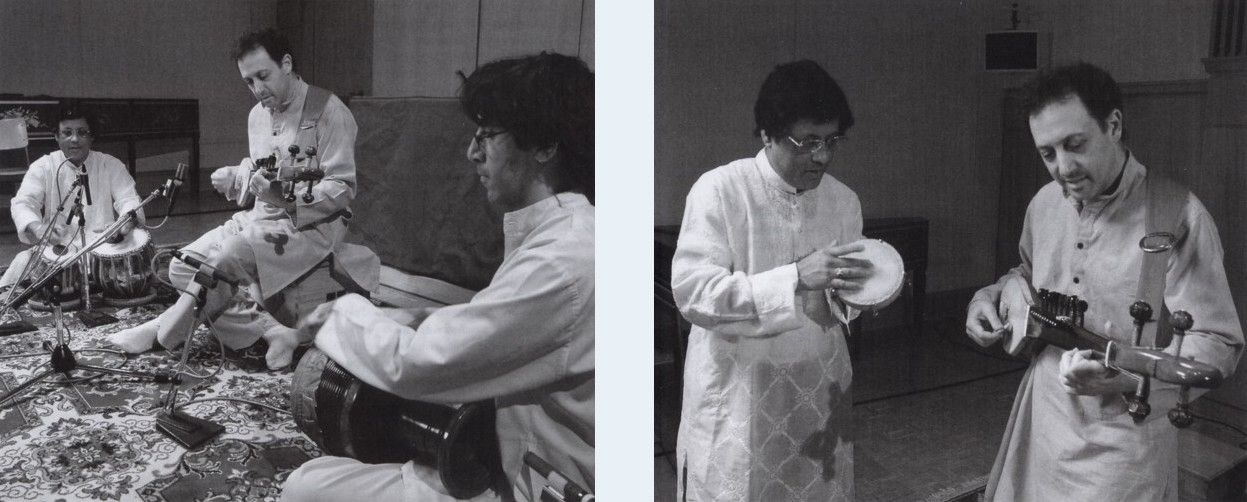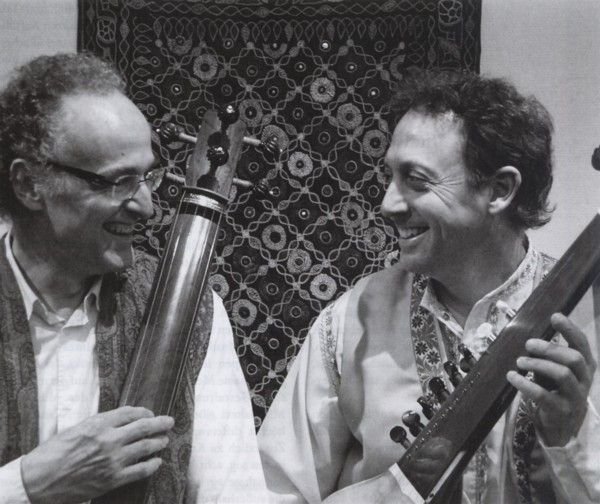Indian ragas & medieval song. Modal melodies from East to West
Dominique Vellard · Ken Zuckerman · Anindo Chatterjee · Keyvan Chemirani

glossamusic.com
Glossa GCD 922508
Schola Cantorum Basiliensis
2007
1 Biaus m'est estez [5:17]
Gace BRULÉ (c.1160-after 1213) · Paris, BNF, fonds fr.
846 (Chansonnier Cangé)
trouvère song - tenor, dhotar
2 Improvisation on
Biaus... [3:30]
Ken Zuckerman (1952)
dhotar, dhupki, gattam
3 In omnem terram [2:31]
Gregorian chant, offertory · Laon 239; Ben. vi. 34
tenor
4 Raga Lankadahang
Sarang [5:42]
Traditional Indian - dhotar, tabla
5 Mors sui, se je
ne vous voy [3:31]
Guillaume de MACHAUT (c.1300-1377) · Paris, BNF, fonds fr. 1584
virelai - tenor, medieval lute
Raga Madhumalati
Traditional Indian (arr. K. Zuckerman) - sarod, tabla, tanpura
6 introduction & middle section [8:10]
7 fast section [6:12]
8 Dis tans plus
qu'il ne faudrait flours [4:06]
Jehannot de l'ESCUREL (fl. early 14th c.) · Paris, BNF, fonds
fr. 146
virelai - tenor, dhotar, tabla, tanpura
9 Improvisation on
Dis tans... [1:53]
Ken Zuckerman - dhotar, tabla, zarb
10 La Charramanga
[3:53]
Anonymous Spanish song - tenor, sarod, tabla, zarb
Compilation by Kurt Schindler, 1930
11 Percussion soli
and duet [5:10]
Traditional Indian and Persian - tabla, zarb, sarod
12 Raga Kousbi
Bhairavi [5:28]
Traditional Indian (arr. K. Zuckerman) - sarod, tabla, zarb, tanpura

Dominique Vellard, tenor, #1 3 5 8 10
Ken Zuckerman, sarod, #6 7 10 11 12, dhotar, #1 2 4 8 9
& medieval lute, #5
Anindo Chatterjee, tabla, #4 6 7 8 9 10 & dhupki, #2
Keyvan Chemirani, zarb, #9 10 11 12 & gattam, #2
with:
Emilie Zuckerman, tanpura, #6 7 8 12
A production of the
Schola Cantorum Basiliensis - University of Early Music at the Musik
Akademie Basel
and Schweizer Radio und Fernsehen
Recorded as a live session on July 3, 2007 at the Musik Akademie Basel
(Kleiner Saal)
Engineered by Schweizer Radio und Fernsehen
Producers: Rolf Grolimund, Artnin Jordi
Recording producers: Charles Suter, Yves Keist
Editing: Ken Zuckerman, Christopher Drummond

Indian ragas &
medieval song
I.
This recording offers a rare opportunity to experience two different
musical traditions in dialogue: the reconstructed musical culture of
the European Middle Ages, and the ancient but still continuous
tradition of North Indian classical music — two worlds that are
indeed separated with respect to time and geography, and yet still
linked by common characteristic features.
The classical tradition of North Indian music is marked both by a
strong adherence to its own origins and an openness to influences from
other cultures. The forms that are still practiced today emerged from a
fusion of Hindu and Islamic traditions. Indian music consists of the
creative interplay between raga (melody) and tala
(rhythm). The largely improvised performances are based on both complex
melodic models and traditional compositions which are passed down over
generations from teacher to pupil. A delicate balance is always
maintained between the proportion of improvised melodic and rhythmic
expressions and the given modal structures and rhythmic cycles. This
interplay between traditional frameworks and spontaneous expression
also enables an active dialogue with the listener who is subtly led
through both the familiar and unexplored territory of the modal and
rhythmic landscape.
European art music of the Middle Ages, seemingly far removed and
accessible only by means of written documents, has clearly recognizable
roots in Eastern traditions. Although the tonal systems are different
(roughly stated: seven whole- and half-tone steps in Western music as
compared to micro intervals and groups of tones in Indian music),
common features can however be recognized in the means of musical
fashioning. In the music of the Middle Ages, too, there are subtle
nuances that can bring about highly differentiated effects. In addition
to compositions and improvisations utilizing the so-called eight church
modes, the present recording also includes several different modes
which are outside the usual modal frameworks and which also include
extensive chromatic alterations.
The modal content of the song accompaniments attempt to create a basic
"raga" structure out of the melodic contours of each song. Thus in Biaus
m'est estez [1] some characteristic elements of the Dorian mode
were integrated with specific melodic phrases of the song to both
"shadow" the vocal line in the style of heterophony, and to provide
material for the following instrumental solo, which placed the
essential melodic phrases in a rhythm of 4 beats [2]. This is also
shown in the Lydian rendering of Dis tans [8] and the following
instrumental solo which accents the lively interplay between the raised
and natural fourth [9]. The performance of raga Lankadahang Sarang
[4] illustrates the use of a traditional raga which shares several
important modal movements with In omnem terram [3]. This is
especially illustrated in the numerous phrases which, unlike most
Dorian compositions, omit the minor 3rd in ascending movements. La
Charramanga [10] and raga Koushi Bhairavi [12] both
illustrate unusual interpretations of "Phrygian" modal ideas. In the
case of the former, chromatic alterations add even more variety to this
evocative melody In the latter, the prominence of the 4th degree over
that of the 5th and the omission of the 2nd and 5th in ascending
passages create a unique effect suggesting, at times, both pentatonic
and transposed tendencies.
As a commentary to the complex modal and chromatic structures of Mors
sui [5], the performance of Madhumalati [6-7] displays a
complex raga that weaves the natural and raised 4th, along with the
natural and flattened 7th, into a rich tapestry of melodic
possibilities. This also illustrates an aspect of the North Indian
system which allows for the creation of new raga structures in addition
to the centuries-old traditional material which has been passed down in
a non-written, oral tradition from teacher to student. The master
musician Ali Akbar Khan (1922-2009), Ken Zuckerman's mentor, composed
this raga during a performance in the 1980s. After the initial
creation, he went on to refine it for several years both through
pedagogical compositions and numerous performances.
¶ Along with the sarod, another Indian instrument — the
dhotar — is employed, both to accompany several of the monophonic
songs and also during some of the instrumental solos. The dhotar is a
folk instrument relative of the sarod, somewhat smaller and also
equipped with fewer sympathetic resonance strings. It is also tuned a
minor third higher than its classical counterpart, which makes it
especially well-suited to accompany monophonic songs.
¶ The virtuosic dialogue between Anindo Chatterjee and Keyvan
Chemirani illustrates the interesting relationship between the highly
evolved tradition of Persian and Indian drumming. This performance
developed spontaneously into a lively conversation by these two masters
[11].
¶ This CD was recorded as a live studio performance rather than a
multi-session, extensively edited recording. Due to time constrictions,
the performances of each piece were limited to one or two complete
takes, at the most. This injected a "live" atmosphere into the
recording session, similar to that of a concert. Thus, both the
spontaneous and improvised excitement of a live performance was
captured albeit at the expense of a "note perfect", extensively edited
CD that has come to be the norm in today's recording world. Of course,
for the Indian music performances, this spontaneity and improvised
atmosphere is an extremely important ingredient to any documentation of
the ragas and talas [4, 6, 7, 11, 12]. But in addition, the improvised
accompaniments of the monophonic songs also benefitted from this "live"
quality [1, 8, 10].
Ken Zuckerman

II.
Lorsque la musique de l'Inde du Nord et la musique occidentale se
rencontrent, on distingue une série de facteurs musicaux
communs. Alors que la musique indienne est profondément
ancrée dans la tradition, il existe déjà dans la
musique européenne médiévale des compositions
fixées par la notation et totalement maîtrisées
tant du point de vue de la forme que du temps musical.
L'interprète se met alors au service de la pensée et de
l'art du compositeur ou d'une école de compositeurs.
Néanmoins, là aussi, les conditions imposées par
la modalité et l'arrangement rythmique découlant de la
déclamation du texte jouent un rôle
préponderánt pour la qualité de la pièce.
Les deux traditions ont une base commune du point de vue de la
modalité. C'est cette base qui nous a dirigés dans la
conception de notre programme. Il faut ici rappeler que le mode est non
seulement une échelle de notes situées dans un ordre
défini de tons et de demi-tons, mais aussi l'essence, la
«physionomie» d'une famille de mélodies ayant des
notes structurelles communes et des mouvements mélodiques plus
ou moins permis. Le chant grégorien (par exemple In omnem
terram [3] de notre programme) a été conçu
indépendamment de la théorie modale plus tardive de l'octoechos
(classification des mélodies en huit modes), comme un art
mélodique créé avant toute théorisation. La
mélodie se développe par succession de degrés
forts (appelés cordes modales) liés entre eux par
des mélismes. Ces degrés principaux sont mis en valeur
par de répetitions des notes et par de courts passages dans les
degrés voisins qui soulignent et renforcent leur position dans
l'échelle. Le rythme du chant grégorien peut être
reconstitué grâce à deux manuscrits neumatiques du
Xe siècle conservés à Saint-Gall et à Laon.
La compréhension de la fonction des neumes et de leur rapport au
texte et à la leçon mélodique permet de redonner
vie à l'une des traditions musicales les plus riches et les plus
abouties de la culture occidentale.
Les compositions monodiques dès le XIIe siècle s'appuient
sur une théorie modale normalisée et simplifiée.
Elles donnent aux différents degrés du mode un rôle
plus hiérarchique et plus fonctionnel dans le discours
mélodique, en particulier à la fin des vers. Ainsi, dans Biaus
m'est estez [1], chanson écrite en mode de ré, les
finales sont fa-ré-fa-ré-la-ré-do-ré. La
composition réserve au troisième quart de la chanson la
partie aiguë du mode, tout le reste se mouvant dans la partie
grave. Le mode se décline donc ainsi :
aigu
do ré mi fa sol sil, sil; do ré
grave
Pour le chant courtois des XIIe et XIIIe siècles, appelé
«grand chant» et toujours attaché à une
poésie de haut style, toute scansion régulière est
bannie. Le rythme découle du placement des mots et des
unités syntactiques sur la mélodie et de leur rapport aux
différents degrés du mode qui structurent la
mélodie. Malgré l'absence de notation rythmique —
et cela peut paraître paradoxal — la liberté dans la
conduite du chant est relativement limitée.
Au début du XIVe siècle, une nouvelle approche rythmique
permet le développement d'un style monodique absolument nouveau (Dis
tans plus [8] et Mors sui [5]). Toujours attachées
à la prosodie issue des modes rythmiques définis par les
compositeurs de l'École de Notre-Dame de Paris, les
mélodies s'appuient désormais sur toutes les
possibilités offertes par un nouveau système de signes de
mesure, que l'on peut comparer en simplifiant aux mesures à 2/4,
3/4, 6/8 et 9/8.
Les développements du contrepoint polyphonique conduirent
finalement à des altérations (vers le haut et vers le
bas) de certains degrés du mode. Ces altérations
offrirent des possibilités nouvelles de coloration de la
mélodie; elles furent utilisées ensuite non seulement
dans la polyphonie mais aussi dans la monodie. Dans Mors sui
[5], qui se situe dans une sorte de mode de ré, le do et le sol
peuvent être altérés: si do♯ ré mi
fa sol/sol♯ la si do ré. Dis tans plus [8] est en mode
de fa, avec la possibilité d'utiliser le si♭, ou le si♮ sur le
quatrième degré (mi fa sol la si♭/si♮ do
ré mi fa).
Du fait des nombreuses analogies et des caractères communs qui
existent entre elles, la musique traditionnelle, encore vivante, est
souvent très riche d'enseignements pour l'interprète de
musique ancienne. Dans La Charramanga [10], collectée
dans les années 1930 en Espagne, deux degrés du mode de
mi peuvent être altérés, donnant ainsi à
cette chanson une saveur particulière: ré/ré♯ mi
fa sol/sol♯ la si do ré.
Avec les pièces de l'Europe médiévale de notre
programme, nous cherchons à montrer à quel point la
tradition sur laquelle se base cette musique est riche — une
tradition qui vit encore, sous une autre form, dans la musique de
l'Inde du Nord.
Dominique Vellard





